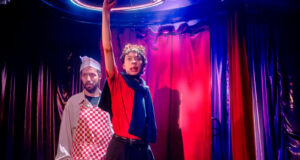A clear-sighted guide intended for theatre directors, whether practicing or aspiring, Adrian Noble’s excellent follow-up to his 2010 How to Do Shakespeare is replete with practical advice and ethical insights. Summary
Rating
Excellent
Adrian Noble works across multiple stage media; theatre of course, but also opera and musicals. His long and varied career, which includes senior management of artistic companies, has however centred around direction. He was the Royal Shakespeare Company’s Artistic Director and Chief Executive for over a decade, from 1990 to 2003. Early in his career he shadowed the legendary actors and theatre company founders Jean-Louis Barrault and Madeleine Renaud, and this proved a profound influence. Noble frequently quotes Barrault’s dictum “Feel passion for everything, but cling to nothing”, which is reflected in his open, collaborative attitude to his craft.
His previous work, How to Do Shakespeare, addresses textual analysis but goes beyond the idea of the director as auteur, to promote the concept of the director as an active people manager. Throughout that book he is consistent in repeatedly describing the actions of the director as leader of a collective venture – in his words, “a traveller open to real collaboration” in an environment where there are multiple stakeholders, all of whom must be dealt with tactfully. Yet the director must still impart a unique vision and inspire all in executing that vision. This thinking underscores the approach of his newest book.
While How to Do Shakespeare focused on language and how to bring the text alive, How to Direct Shakespeare takes the reader, practical step by practical step, through all the key stages of theatre production, including concept, casting, set and sound design, rehearsal processes, technical aspects, previews and openings.
Noble is emphatic that this work be underpinned by craft and technique: that the director must develop over time a strong methodology as well as a clear artistic vision. Perhaps the latter cannot exist without the former. “What if someone asks you: what is your concept?” he points out. Has the director created a logical world? Articulated shape, structure and mood? Are language and motivation ingegrated? Have the actors developed a sense of the architecture of their role?
These are all penetrating questions, and asked with warmth and intelligence. Noble is generous in suggesting games and exercises, different approaches to auditions and rehearsals, and provides guidance to the last detail, even describing different ways to direct curtain calls.
The greatest pleasure here is how the author fulfills the promise inherent in the title of the book. This is about Shakespeare, after all, and what Noble shares is limpid, enlightening, and inspiring. He describes Shakespeare’s use of language – apposition, metaphor, metre and pulse, line endings, vocabulary, shape, and structure – and illustrates this powerfully. Reading those pages aloud brings it all to life.
Noble explains that his methods “carry the meaning, the character, the atmosphere and the cosmology of the play” and reiterates something that perhaps all his readers know on one level, yet possibly not all that deeply: that in Shakespeare’s time, language had to fulfill all sorts of functions nowadays occupied by stagecraft, set design, lighting, music. Shakespeare had the stage, the voice, the words, yet with only this, he created entrancing worlds.
Written engagingly, with warmth and enthusiasm, Noble’s enabling instruction empowers Shakespeare’s own world, as writer and director, to come to life.
Author: Adrian Noble
Published by: The Arden Shakespeare, 2022
How To Direct Shakespeare was released 8 September, and is available in paperback and e-book formats from all good book stores.
 Everything Theatre Reviews, interviews and news for theatre lovers, London and beyond
Everything Theatre Reviews, interviews and news for theatre lovers, London and beyond



